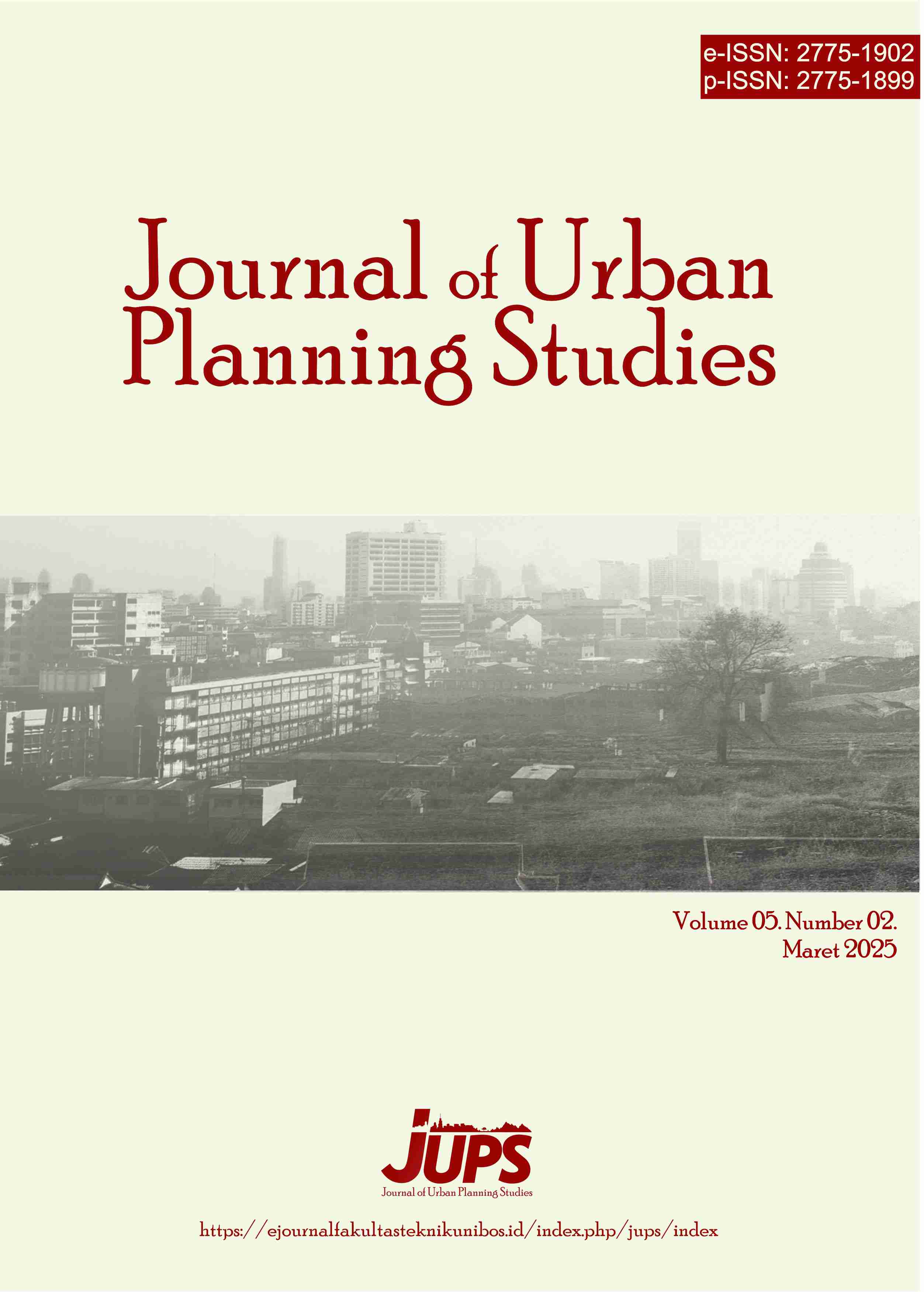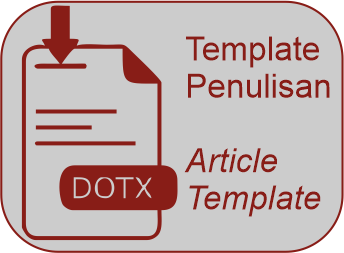Penataan Kawasan Wisata Pesisir Dalam Mendukung Usaha Mikro Kecil dan Menengah Kota Makassar
DOI:
https://doi.org/10.35965/jups.v5i2.674Kata Kunci:
Wilayah pesisir, Pariwisata, UMKM, Potensi sumber daya, penataan ruang, pantai biruAbstrak
Abstrak. Penelitian ini bertujuan untuk menata kawasan wisata pesisir Pantai Biru di Kota Makassar guna mendukung Usaha Mikro, Kecil, dan Menengah (UMKM). Pendekatan penelitian kualitatof sangat diperlukan pada penelitian ini untuk menentukan konsep penataan ruang yang jelas serta perhatian dari masyarakat dan pemerintah untuk menjadikan Pantai Biru sebagai destinasi wisata yang teratur, indah, dan nyaman. Hasil penelitian ini menjelaskan bahwa perlunya peningkatan saran dan penataan lahan di kawasan pariwisata pesisir, khususnya penataan lokasi sarana pendukung UMKM di sekitar kawasan pariwisata pesisir, selanjutnya peningkatan prasarana dan aksesibilitas pada kawasan pariwisata.
Referensi
Aflaha, R., Handayani, P. W., & Damayanti, R. (2020). Coastal tourism planning to support the creative economy in Indonesia. International Journal of Tourism Cities, 6(3), 559–574.
Barragán, J. M., & de Andrés, M. (2019). Analysis and trends of the world's coastal cities and agglomerations. Ocean & Coastal Management, 171, 22–32.
Blakely, E. J., & Leigh, N. G. (2013). Planning local economic development: Theory and practice (5th ed.). SAGE Publications.
Briones-Peñalver, A. J., Bernal-Conesa, J. A., & de Nieves-Nieto, C. (2023). Sustainable development in coastal tourism: Strategies for infrastructure and community participation. Sustainability, 15(2), 712.
Briones-Peñalver, A.-J., Prokopchuk, L., & Samoilyk, I. (2023). Strategic vectors of coastal tourism development as a blue economy component in the international dimension. Journal of Environmental Management and Tourism, 14(6), 2473–2496.
Carter, N., Bryant-Lukosius, D., DiCenso, A., Blythe, J., & Neville, A. J. (2014). The use of triangulation in qualitative research. Oncology Nursing Forum, 41(5), 545–547.
Chambers, R. (1997). Whose reality counts? Putting the first last. Intermediate Technology Publications.
Corboș, R.-A., Bunea, O.-I., & Moncea, M. I. (2024). A literature review on tourism infrastructure investments and their impact on tourism development. Proceedings of the International Conference on Business Excellence, 18(1), 268–278.
Fadhilah, I. N. (2022). The role of tourism infrastructure development in empowering local MSMEs: A case study in coastal areas of Southeast Asia. Journal of Tourism and Hospitality Management, 10(4), 65–78.
Fennell, D. A. (2021). Ecotourism (5th ed.). Routledge.
Giampiccoli, A., & Mtapuri, O. (2020). Community-based tourism: Critical success factors. International Journal of Tourism Cities, 6(1), 125–139.
Goeldner, C. R., & Ritchie, J. R. B. (2012). Tourism: Principles, practices, philosophies (12th ed.). Wiley.
Gössling, S., & Hall, C. M. (2019). Sustainable tourism: A global perspective. Journal of Sustainable Tourism, 27(7), 889–903.
Gunawan, H., Purnaweni, H., & Suharyo, O. S. (2020). Community empowerment strategy through coastal tourism: A case in Central Java. IOP Conference Series: Earth and Environmental Science, 584(1), 012027.
Hailuddin, H., Abdulkarim, A., & Ismail, H. N. (2022). Muslim-friendly tourism facilities in coastal destinations: Enhancing spiritual comfort and inclusivity. International Journal of Tourism Cities, 8(1), 45–58.
Herrera-Franco, G., Suárez-Castillo, A. N., & Gallo, P. J. (2022). Integrating spatial planning and local economic development: A framework for resilient coastal communities. Land Use Policy, 112, 105812.
Ilham, B. U., Dirwan, D., & Randa, A. (2023). Pengembangan UMKM terpadu berbasis zona KHAS (Kuliner Halal, Aman, dan Sehat) di kawasan wisata Lego-Lego Makassar. Jurnal Manajemen STIE Muhammadiyah Palopo, 9(2), 315–335.
Inskeep, E. (1991). Tourism planning: An integrated and sustainable development approach. Van Nostrand Reinhold.
Jangra, R., Kaushik, S. P., Singh, E., Kumar, P., & Jangra, P. (2023). The role of transportation in developing the tourism sector at high altitude destination, Kinnaur. Environment, Development and Sustainability.
Jangra, S., Sharma, A., & Sharma, R. (2023). The role of transportation in tourism development: A case study of Kinnaur district. Journal of Tourism and Hospitality, 12(3), 45–58.
Johannis, A., Eryani, R., & Wijaya, M. (2022). Sustainable sanitation facilities and tourist satisfaction in beach destinations: A structural equation model approach. Asia Pacific Journal of Tourism Research, 27(6), 569–585.
Junaid, I. (2021). Pemberdayaan masyarakat pesisir melalui pariwisata berbasis UMKM. Politeknik Pariwisata Makassar.
Kim, M. J., Lee, C. K., & Jung, T. (2023). Smart tourism city development for sustainable urban tourism: Lessons from Asian coastal cities. Tourism Management Perspectives, 46, 101070.
Korstjens, I., & Moser, A. (2018). Practical guidance to qualitative research. Part 4: Trustworthiness and publishing. European Journal of General Practice, 24(1), 120–124.
Liu, Y., Wang, S., & Li, J. (2022). The contribution of tourism mobility to tourism economic growth in China. PLOS ONE, 17(10), e0275605.
Mappagala, A. B. (2017). Penataan ruang kawasan tepi pantai Mattirotasi dalam menunjang kepariwisataan di Kota Parepare (Skripsi). Universitas Islam Negeri Alauddin Makassar.
Nayak, S., Dash, S., & Mishra, B. B. (2020). Sustainable development and resilience of coastal tourism in the face of climate change: Insights from India. Sustainability, 12(5), 1765.
Noble, H., & Heale, R. (2019). Triangulation in research, with examples. Evidence-Based Nursing, 22(3), 67–68.
Nowell, L. S., Norris, J. M., White, D. E., & Moules, N. J. (2017). Thematic analysis: Striving to meet the trustworthiness criteria. International Journal of Qualitative Methods, 16(1), 1–13.
Parasuraman, A., Zeithaml, V. A., & Berry, L. L. (1988). SERVQUAL: A multiple-item scale for measuring consumer perceptions of service quality. Journal of Retailing, 64(1), 12–40.
Popescu, R. I., & Corboș, R. A. (2017). The role of transport infrastructure in tourism development: Case study of Romania. Procedia Engineering, 181, 1045–1051.
Randone, M., Fernandes, L., Halpern, B. S., et al. (2017). Coastal tourism and environmental degradation: The need for spatial planning and sustainable governance. Marine Policy, 87, 1–6.
Rangel-Buitrago, N., & Anfuso, G. (2021). Coastal scenic assessment and tourism carrying capacity in rapidly urbanizing coastal areas. Sustainable Cities and Society, 68, 102782.
Suwantoro, G. (2004). Dasar-dasar pariwisata (Ed. 2). Andi.
Swarbrooke, J. (2015). Sustainable tourism management. CABI Publishing.
Trisnawati, I., Satria, A., & Nurani, T. W. (2021). Coastal tourism development and local community participation in Indonesia: A policy analysis. Ocean & Coastal Management, 199, 105402.
UNWTO. (2022). Tourism and Sustainable Development Goals – Progress Report. United Nations World Tourism Organization.
Wang, H., et al. (2025). Towards management of sustainable tourism development in coastal destinations of the Bohai Rim: Insights from a tourism carrying capacity analysis. Discover Sustainability, 6(168).
Wang, Y., Zhang, L., & Li, Q. (2025). Managing tourism carrying capacity in coastal destinations: A framework for sustainable infrastructure planning. Journal of Sustainable Tourism, 33(1), 25–44.
##submission.downloads##
Diterbitkan
Cara Mengutip
Terbitan
Bagian
Lisensi
Hak Cipta (c) 2025 Naliya Marshandie, Batara Surya, Syafri, Nur Okviyani

Artikel ini berlisensi Creative Commons Attribution 4.0 International License.













